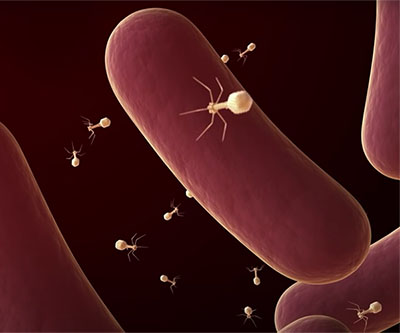
Bacteriophages attacking bacteria.
Credit: NIAID
The precise functions of bacterial recombination-promoting nuclease (Rpn) proteins remain unclear. Recent work by the Storz Lab revealed that that genes that provide instructions for complete, full-length Rpn proteins (RpnL) include genes-within-genes that separately produce smaller versions of the proteins (RpnS).
The researchers found that the small RpnS proteins directly block the activities of RpnL, which can act as a toxin—a molecule that helps promote infection or disease. RpnS thus serves as an antitoxin. All proteins are built from amino acids, and amino acid repeats—segments made of simple amino acid patterns—play important roles in protein structure and function. Both RpnL and RpnS contain a particular four-amino-acid repeat. The scientists observed that the number of these repeats in RpnS varies widely among different strains of the same bacterial species, suggesting a possible role in defense against phages, viruses that infect bacteria. Further experiments revealed that the RpnL-RpnS toxin-antitoxin system helps protect the bacterium Escherichia coli against infection with certain phages.
The authors propose that such genes-within-genes are likely not restricted to toxin-antitoxin genes and may be far more prevalent in all types of organisms than previously thought.
NICHD co-authors of the paper include Aoshu Zhong and Katherine Klier.
Learn more about the Cell and Structural Biology group: https://www.nichd.nih.gov/about/org/dir/affinity-groups/CSB
 BACK TO TOP
BACK TO TOP